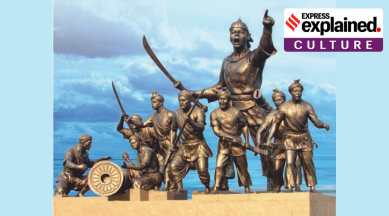The heroism of Lachit Borphukan, legendary Ahom general and proud symbol of Assamese self-identity
Who was Lachit Borphukon, and why is he significant in the narrative of Assamese nationalism?

A three-day celebration of the 400th birth anniversary of the legendary Assamese general and folk hero Lachit Borphukan began in New Delhi on November 23. The ceremony will be attended by Prime Minister Narendra Modi, Home Minister Amit Shah, Finance Minister Nirmala Sitharaman, and Law Minister Kiren Rijiju among others.
Last week, Assam Chief Minister Himanta Biswa Sarma released a theme song composed by singer Zubin Garg as part of its ongoing celebration of the 400th birth anniversary of the Ahom general. The song was a tribute to the sacrifice of ‘Mahabir’ Lachit, Sarma said, and hoped that it would boost “nationalistic fervour” among the people.
Earlier this year, then President Ram Nath Kovind had inaugurated the celebrations in Guwahati, laying the foundation stone for a war memorial and a 150-foot bronze statue of the hero.
So, who was Lachit Borphukon, and why is he significant in the narrative of Assamese nationalism?
History of the Ahom kingdom
The Ahom kings ruled large parts of what is now known as Assam for nearly 600 years, from the early 13th century to the early 19th century. This was a prosperous, multi-ethnic kingdom which spread across the upper and lower reaches of the Brahmaputra valley, surviving on rice cultivation in its fertile lands.
The Ahoms engaged in a series of conflicts with the Mughals from 1615-1682, starting from the reign of Jahangir till the reign of Aurangzeb. One of the major early military conflicts was in January 1662, where the Mughals won a partial victory, conquering parts of Assam and briefly occupying Garhgaon, the Ahom capital.
The counter-offensive to reclaim lost Ahom territories started under Ahom King Swargadeo Chakradhwaja Singha. After the Ahoms enjoyed some initial victories, Aurangzeb dispatched Raja Ram Singh I of Jaipur in 1669 to recapture the lost territory — eventually resulting in the Battle of Saraighat in 1671.
Legend of Lachit Borphukan
Lachit was a brilliant military commander who knew the terrain of the Brahmaputra valley and the surrounding hills like the back of his hand. He was chosen as one of the five Borphukans of the Ahom kingdom by king Charadhwaj Singha, and given administrative, judicial, and military responsibilities.
Unlike the Mughals who preferred battles in the open with their massive armies, Borphukan preferred guerrilla tactics which provided an edge to his smaller, but fast moving and capable forces. Much like Shivaji’s encounters with the Mughals in Marathwada, Lachit inflicted damage on the large Mughal camps and static positions. His raids would kill unsuspecting Mughal soldiers and frustrate the mighty armies that were too ponderous to respond swiftly.
When the monsoon set in, Mughal plans were complicated further. However, as the Mughals were able to successfully camp around the foothills of Alaboi, the Ahom king ordered Borphukan to carry out a frontal assault which led to the deaths of nearly 10,000 Ahom warriors and ended in a weary Mughal victory in 1669.
As the Mughals attempted to progress through the valley, they realised that travelling by the river would be faster. Lachit, who was a great naval warrior and strategist, created an intricate web of improvised and surprise pincer attacks. According to the historian H K Barpujari (‘The Comprehensive History of Assam’), the Ahom forces combined a frontal attack with a surprise attack from behind. They lured the Mughal fleet into moving ahead by feigning an attack with a few ships from the front. The Mughals vacated the waters behind them, from where the main Ahom fleet attacked and achieved a decisive victory.
Lachit Borphukan died a year after the Battle of Saraighat from a long festering illness. In fact he was very ill during the Battle of Saraighat, as he heroically led his troops to victory. This only added to his legend.
Lachit Borphukan in Assamese culture
Every culture and community has its heroes. Over time, Lachit Borphukan’s exploits have become a symbol of resistance against outsiders against all odds. He has become one of the greatest of Assamese heroes, symbolising the valour, courage, and intelligence that defines the Assamese self-identity.
Arup Kumar Dutta, author of The Ahoms, told The Indian Express last year that Lachit Borphukan represented a time when the “Assamese race was united and able to fight an alien, formidable force such as the Mughals”.
Dr Jahnabi Gogoi, a professor of mediaeval history in Dibrugarh University, told The Indian Express last year that Lachit Divas has been celebrated on November 24, his birth anniversary, in Assam since the 1930s.